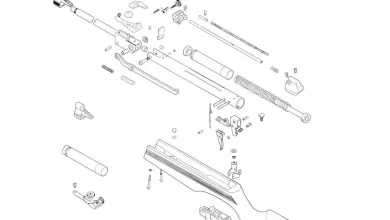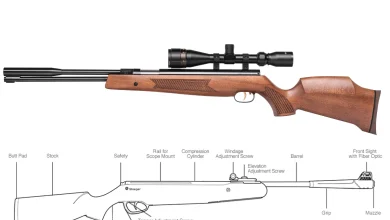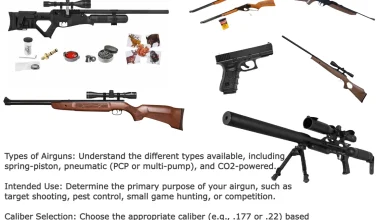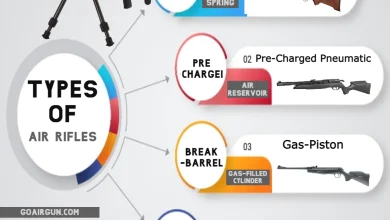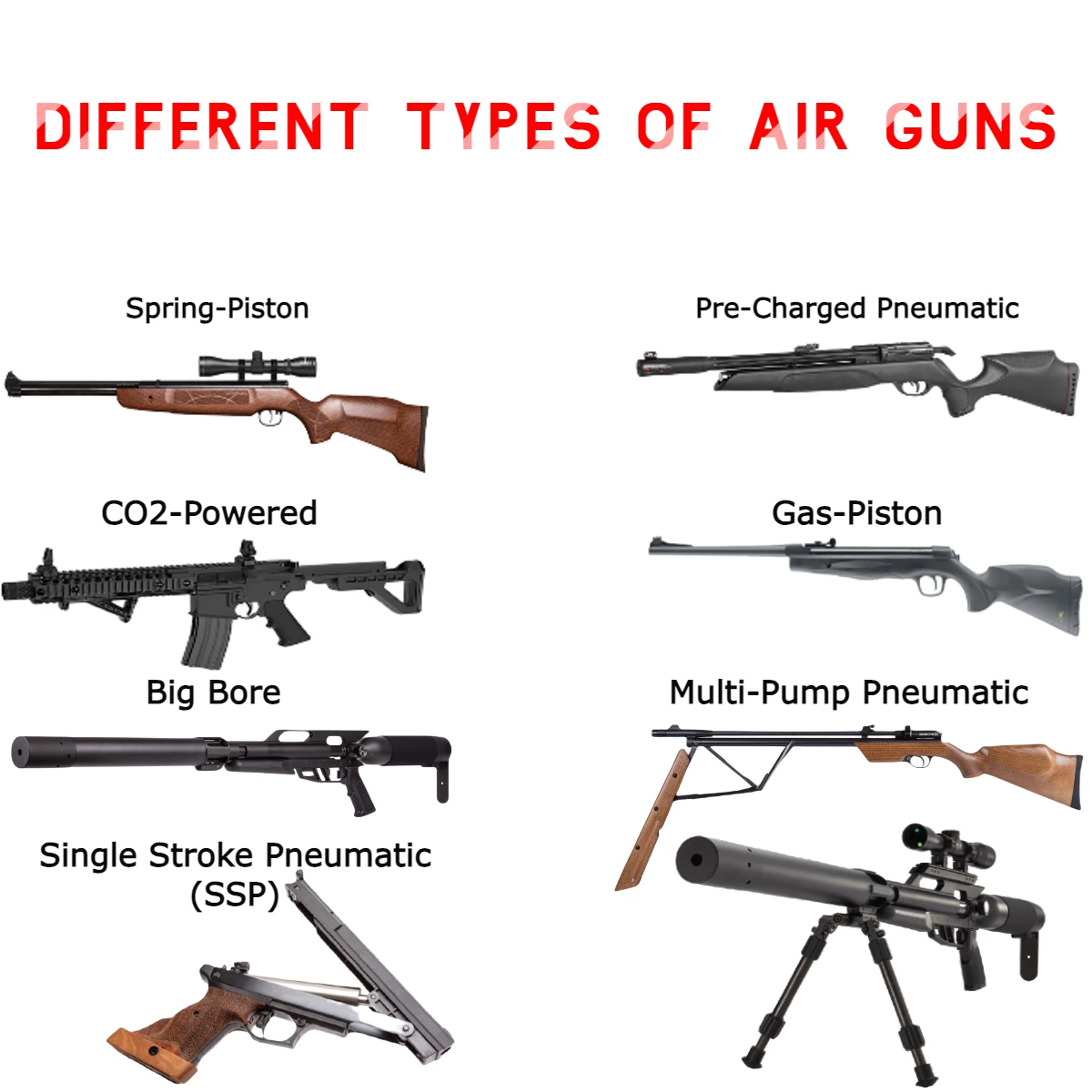
Whether you’re a seasoned marksman or a budding enthusiast, understanding the different types of air guns will undoubtedly enhance your shooting experience. So, let’s dive in and explore the various categories of air guns, each offering its own unique blend of power, precision, and fun! Read on to unleash the full potential of your shooting prowess and discover the perfect air gun that will accompany you on all your shooting escapades.
Are you ready to take your shooting to new heights? Uncover the hidden gems among air guns and find your perfect shooting companion today! Let’s delve into the exciting world of air guns and embark on an unforgettable journey of marksmanship. Keep reading to the end of my blog to discover the ideal air gun that will elevate your shooting experience to new heights! Don’t miss out on this thrilling adventure – let’s get started!
10 Different Types of Air Guns: Choose Perfect Shooting Companion
| Type of Air Gun | Features | Applications |
|---|---|---|
| Spring-Piston | – Simple design, moderate power | – Target shooting, plinking, small game hunting |
| CO2-Powered | – Semi-automatic or automatic firing | – Recreational shooting, airsoft games, backyard plinking |
| Pre-Charged Pneumatic (PCP) | – High accuracy, adjustable power settings | – Competitive target shooting, hunting |
| Gas-Piston | – Reduced vibration and recoil, longer lifespan | – Target shooting, pest control |
| Multi-Pump Pneumatic | – Adjustable power levels with manual pumping | – Plinking, target shooting, small game hunting |
| Big Bore | – Powerful, suitable for hunting large game | – Large game hunting, ethical hunting practices |
| Lever-Action | – Nostalgic and smooth lever-action shooting | – Plinking, target shooting, small game hunting |
| Single Stroke Pneumatic (SSP) | – Easy to use with a single pump for compressed air | – Casual plinking, target shooting |
| Repeating | – Rapid-fire shooting with semi-automatic or automatic modes | – Recreational shooting, airsoft games |
| Air Pistols | – Compact and portable for easy handling | – Recreational shooting, target practice |
1. Spring-Piston Air Guns
Overview: Spring-piston air guns, also known as break-barrel air rifles, are one of the most popular and traditional types of air guns. As the name suggests, these guns use a powerful spring to compress air behind a piston. When you cock the gun by breaking the barrel and then release it, the spring decompresses, pushing the piston forward to create a blast of compressed air that propels the pellet or BB out of the barrel.
Features and Applications: Spring-piston air guns are widely used for various shooting purposes, such as target shooting, plinking, and small game hunting. They come in different power levels, from low-powered options suitable for beginners and youth shooters to high-powered models capable of taking down small pests and game.
One of the significant advantages of spring-piston air guns is that they are relatively simple in design, making them easy to maintain. However, mastering the shooting technique can be a bit challenging, as the recoil from the spring can affect accuracy. With practice, though, many shooters find spring-piston guns to be rewarding and fun to shoot.
Pros:
- Versatile use for target shooting and hunting small game.
- Simple design, easy to maintain.
- Wide range of power options to suit different users.
Cons:
- Requires a learning curve to manage recoil and improve accuracy.
- Can be loud compared to other air gun types.
2. CO2-Powered Air Guns
Overview: CO2-powered air guns utilize compressed carbon dioxide (CO2) gas as their propellant. These guns are often semi-automatic, allowing for rapid firing without the need to manually cock the gun between shots. CO2 cartridges or canisters are inserted into the gun, and when the trigger is pulled, a small amount of CO2 is released, propelling the projectile.
Features and Applications: CO2-powered air guns are favored for their ease of use and quick follow-up shots. They are great for plinking, recreational shooting, and some target shooting activities. Additionally, they are often used in airsoft games due to their semi-automatic or automatic firing capabilities.
These air guns typically shoot steel BBs or pellets at a moderate velocity, making them suitable for backyard shooting without the need for a large shooting range. However, it’s essential to note that CO2 guns can be affected by temperature changes, with performance decreasing in colder weather.
Pros:
- Semi-automatic or automatic firing for rapid shots.
- Easy to use and suitable for recreational shooting.
- Ideal for airsoft games and backyard plinking.
Cons:
- Performance can be affected by temperature changes.
- CO2 cartridges need to be replaced regularly.
3. Pre-Charged Pneumatic (PCP) Air Guns
Overview: Pre-Charged Pneumatic (PCP) air guns are known for their high accuracy, power, and consistency. They work on the principle of using pre-compressed air to propel the projectile. To charge the gun, you’ll need a high-pressure air source, such as a hand pump or a scuba tank, to fill the onboard air reservoir.
Features and Applications: PCP air guns are popular among serious shooters, including competitive target shooters and hunters. The compressed air provides a consistent and recoil-free shooting experience, allowing for precise shot placement. These guns often come with adjustable power settings, giving shooters the flexibility to choose the right level of velocity for their specific needs.
The main drawback of PCP air guns is the need for an external air source to recharge the gun’s reservoir. However, this can be mitigated by using high-capacity air tanks or pumps, which allow for multiple fills before needing to be refilled themselves.
Pros:
- High accuracy and consistency.
- Recoil-free shooting for better precision.
- Adjustable power settings for versatility.
Cons:
- Requires an external air source for recharging.
- Initial setup costs can be higher compared to other air guns.
4. Gas-Piston Air Guns
Overview: Gas-piston air guns, also known as gas-spring or gas-ram air guns, are similar to spring-piston guns in design but use gas instead of a coiled spring to provide the power. These guns utilize a gas-filled cylinder that compresses when the gun is cocked. When the trigger is pulled, the compressed gas expands, driving the piston forward to propel the pellet or BB.
Features and Applications: Gas-piston air guns offer several advantages over traditional spring-piston guns. They generate less vibration and recoil, leading to smoother shooting and improved accuracy. Additionally, gas-piston guns tend to have a longer lifespan since there is no metal fatigue associated with coil springs.
These air guns are well-suited for various shooting activities, including target shooting and pest control. They are also a good option for those who want the power and consistency of a spring-piston gun but prefer a smoother shooting experience.
Pros:
- Reduced vibration and recoil for smoother shooting.
- Longer lifespan compared to spring-piston guns.
- Suitable for target shooting and pest control.
Cons:
- Can be more challenging to cock due to gas pressure.
- Limited availability of aftermarket tuning parts compared to spring-piston guns.
5. Multi-Pump Pneumatic Air Guns
Overview: Multi-pump pneumatic air guns are a classic and straightforward type of air gun. These guns use manual pumping action to compress air and store it in an onboard reservoir. The more times you pump the gun, the higher the air pressure, and consequently, the greater the velocity of the projectile.
Features and Applications: Multi-pump pneumatic air guns are often regarded as entry-level air rifles due to their ease of use and affordability. They are great for beginners and young shooters, as the pumping action allows users to adjust the power level according to their shooting skills and intended target.
These air guns are typically used for plinking, target shooting, and small game hunting. They offer a convenient shooting experience, as they don’t rely on external power sources like CO2 or compressed air tanks.
Pros:
- Adjustable power levels with manual pumping action.
- Affordable and user-friendly, ideal for beginners.
- Versatile use for plinking and small game hunting.
Cons:
- Requires manual pumping for each shot, which can be tiring.
- Limited power compared to other air gun types.
6. Big Bore Air Guns
Overview: Big bore air guns are the heavy-hitters of the air gun world, designed to shoot larger caliber projectiles. Unlike the smaller calibers used in other air guns, big bore air guns can fire projectiles ranging from .30 caliber up to .50 caliber or even larger.
Features and Applications: Big bore air guns are predominantly used for hunting large game, such as deer, hogs, and even some species of African game. These guns are popular among hunters who want a quieter and more eco-friendly alternative to traditional firearms while still maintaining sufficient stopping power.
Due to the larger caliber and higher air pressure required, big bore air guns are often pre-charged pneumatic (PCP) guns. They deliver substantial energy with impressive accuracy, making them a top choice for ethical and responsible hunting.
Pros:
- Powerful and suitable for hunting large game.
- Quieter and more eco-friendly than traditional firearms.
- High accuracy and stopping power.
Cons:
- Generally more expensive than standard air guns.
- Limited availability of ammunition compared to firearms.
7. Lever-Action Air Guns
Overview: Lever-action air guns are inspired by the classic lever-action rifles found in the Old West. These guns have a lever located under the barrel that you need to cycle back and forth to cock the gun and load the pellet or BB into the chamber. Once the lever is in the firing position, pulling the trigger releases the compressed air, propelling the projectile.
Features and Applications: Lever-action air guns offer a nostalgic shooting experience and are often popular among shooters who appreciate the historical charm of lever-action firearms. They are ideal for plinking and target shooting, providing a smooth and enjoyable shooting motion.
These guns are typically powered by a spring or gas-piston mechanism, offering moderate power suitable for backyard shooting and small game hunting. Lever-action air guns are also a great option for introducing beginners to the shooting sport, thanks to their user-friendly operation.
Pros:
- Nostalgic and smooth lever-action shooting.
- Suitable for plinking, target shooting, and small game hunting.
- User-friendly and ideal for beginners.
Cons:
- Limited power compared to other air gun types.
- Lever cycling can be slower compared to other cocking mechanisms.
8. Single Stroke Pneumatic (SSP) Air Guns
Overview: Single Stroke Pneumatic (SSP) air guns, also known as single pump or single-stroke air guns, are among the simplest and easiest to use air guns available. As the name suggests, you only need to perform a single stroke or pump to charge the gun with compressed air.
Features and Applications: SSP air guns are popular for their straightforward operation and low maintenance requirements. They are ideal for beginners, youth shooters, and those looking for a hassle-free shooting experience. With just one pump, you’re ready to take a shot, making them convenient for casual plinking and target shooting.
These air guns usually shoot lightweight pellets at relatively low velocities, which is perfect for shooting in confined spaces or areas with limited backstop options. SSP air guns are not suitable for hunting due to their limited power, but they are excellent for recreational use.
Pros:
- Easy to use with a single pump for compressed air.
- Low maintenance and user-friendly.
- Suitable for casual plinking and target shooting.
Cons:
- Limited power and not suitable for hunting.
- Lower velocity compared to other air gun types.
9. Repeating Air Guns
Overview: Repeating air guns are designed to hold multiple rounds and fire them in quick succession without the need to manually reload between shots. These guns can be either semi-automatic or fully automatic, providing a rapid-fire shooting experience.
Features and Applications: Repeating air guns are typically powered by CO2 or pre-charged pneumatic systems, allowing for rapid follow-up shots without the need to manually cock the gun. They are often used in airsoft games, where players engage in mock combat using air guns firing plastic BBs.
These air guns are perfect for airsoft enthusiasts who want a more authentic shooting experience. They offer semi-automatic or automatic firing modes, providing a thrilling and action-packed shooting session. However, it’s essential to use proper safety gear and follow guidelines when engaging in airsoft games or similar activities.
Pros:
- Rapid-fire shooting with semi-automatic or automatic modes.
- Ideal for airsoft games and action-packed shooting.
- Convenient for quick follow-up shots.
Cons:
- Limited applications beyond recreational shooting and airsoft games.
- Requires proper safety precautions and protective gear.
10. Air Pistols
Overview: Air pistols are compact and portable air guns designed to be held and operated with one hand. They come in various designs, including replicas of real firearms and purpose-built target pistols. Air pistols can be powered by CO2 cartridges, compressed air, or spring-piston mechanisms.
Features and Applications: Air pistols are great for recreational shooting, target practice, and plinking. Due to their compact size, they can be easily used in indoor shooting ranges or backyard shooting setups. Many air pistols are modeled after real firearms, making them popular among collectors and those who want to practice shooting with a similar grip and feel to their real counterparts.
These pistols often shoot pellets or BBs at lower velocities compared to air rifles, but they are still capable of providing an enjoyable shooting experience. Some air pistols are also used in competitive shooting sports like 10-meter air pistol shooting.
Pros:
- Compact and portable for easy handling.
- Suitable for recreational shooting and target practice.
- Some models replicate the look and feel of real firearms.
Cons:
- Lower velocities compared to air rifles.
- Limited power and range compared to larger air guns.
Factors to Consider When Selecting Between Types of Air Guns
Choosing the right type of air gun can significantly impact your shooting experience and overall satisfaction. Here are essential factors to consider when selecting between the various types of air guns available:
- Intended Use: Consider your primary shooting purpose. Are you looking for an air gun for target shooting, plinking, pest control, or hunting? Different types of air guns are designed to excel in specific applications, so aligning your intended use with the capabilities of the air gun is crucial.
- Power and Velocity: The power and velocity of an air gun determine its effectiveness for various shooting activities. If you plan to hunt small or large game, you’ll need a more potent air gun, such as a big bore or PCP. For casual plinking or target shooting, a lower-powered option like a spring-piston or CO2-powered air gun may suffice.
- Shooting Range: Consider where you’ll be shooting. Some air guns have limited range, making them more suitable for indoor shooting ranges or backyard plinking, while others offer greater range and accuracy for long-distance target shooting.
- Recoil and Shooting Comfort: Different types of air guns exhibit varying levels of recoil and shooting characteristics. Spring-piston guns, for example, may have more recoil than gas-piston or PCP guns. Choose an air gun that aligns with your comfort level and shooting preferences.
- Shooting Mechanism: The cocking mechanism can impact the ease of use and convenience of the air gun. Spring-piston and gas-piston guns require manual cocking, while CO2-powered and PCP guns offer semi-automatic or automatic firing.
- Cost and Budget: Consider the initial cost and ongoing expenses. Some air guns, like PCP models, can have higher upfront costs due to the need for a charging system. Additionally, factor in the cost of ammunition, maintenance, and any accessories you may need.
- Skill Level: For beginners, user-friendly air guns like multi-pump pneumatic or CO2-powered options are recommended. More experienced shooters may appreciate the precision and power offered by PCP or big bore air guns.
- Shooting Environment and Regulations: Check local laws and regulations regarding air gun ownership, shooting locations, and restrictions. Some areas may have specific rules regarding air gun usage, so ensure you comply with all legal requirements.
- Accessories and Upgrades: Consider the availability of accessories and aftermarket upgrades for the type of air gun you choose. Some shooters enjoy customizing their air guns to enhance performance and aesthetics.
- Personal Preference: Ultimately, your personal preferences and shooting style play a significant role in selecting the right air gun. Handle different types of air guns if possible, and choose the one that feels comfortable and suits your shooting aspirations.
By carefully considering these factors, you can make an informed decision and find the perfect type of air gun that will bring you countless hours of shooting enjoyment and satisfaction. Happy shooting!
FAQs
For target shooting, both spring-piston air guns and pre-charged pneumatic (PCP) air guns are excellent choices. PCP air guns offer high accuracy and adjustable power settings, making them popular among competitive target shooters. Spring-piston air guns, on the other hand, are versatile and great for casual target shooting.
Yes, some types of air guns, like big bore air guns, are suitable for hunting small and large game. Big bore air guns provide enough power and velocity to ethically take down animals like deer and hogs.
CO2-powered air guns offer the advantage of semi-automatic or automatic firing, allowing for rapid follow-up shots without manually cocking the gun. They are ideal for recreational shooting and airsoft games.
Air pistols are not considered suitable for self-defense purposes. They typically shoot lightweight pellets at lower velocities, making them less effective for personal protection compared to conventional firearms.
For beginners, multi-pump pneumatic air guns are a good choice. They are user-friendly, affordable, and allow shooters to adjust the power levels according to their skill level.
Laws regarding air guns vary by country and region. It’s essential to check local regulations regarding the ownership, use, and shooting locations for air guns in your area.
Consider your shooting preferences, intended applications (target shooting, hunting, plinking), and experience level when choosing an air gun. Research the features and performance of different types before making a decision.
Yes, like any mechanical device, air guns require regular maintenance to ensure optimal performance. Regularly clean and lubricate your air gun, and follow the manufacturer’s guidelines for maintenance.
No, air guns require specific types of ammunition such as pellets or BBs designed for air gun use. Using regular firearms ammunition in an air gun can be dangerous and cause damage to the gun. Always use the appropriate ammunition for your specific air gun model.
